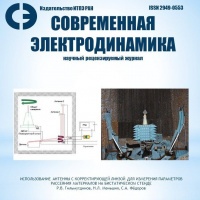
Contents
Section 1. Topics on experimental electrodynamics
Thermoelectric optical radiation receiver type TP-1
A.S. Ilyin, M.N. Pavlovich
Abstract
It is shown that it is necessary to create a domestic optical radiation receiver capable of measuring constant optical radiation fluxes in the illumination range from 1 to 2000 W/m2, in the spectral range from 0.5 to 20 microns with a measurement time of no more than 2 seconds. The characteristics of the best domestic thermoelectric radiation receivers operating in the same ranges, but, according to the set of characteristics, do not meet the set requirements, are given. The receiver design has been developed: the sensing unit is mounted on a standard leg, the receiver body has a diameter of 15 mm, height – 9 mm. The entrance window is zinc selenide, if necessary, windows made of other materials can be used. A stand has been developed to measure the conversion coefficient and to study its dependence on the level of illumination. A thermoelectric receiver of the POI-1 type was used as an exemplary receiver, having a receiving element in the form of a cone on which an electric substitution winding is located. The developed receiver had the following main characteristics: KP = (0, 5 ± 0, 2) V/W, time constant τ = 0, 4 s, time of one measurement T =≤ 2 s, resistance R = (0.5 ± 0.2) ohms, size of the receiving area ΑP = (4 × 1) mm2, spectral range from 0.5 to 20 microns, detection capacity D* = 8 · 108 см· Hz0.5· W−1, which corresponds to the best uncooled thermal radiation receivers.The blackening coating provides a high absorption coefficient of ελ ≈ 0, 93 − 0, 98 in the range from 0.4 to 25 microns. The limit of the basic error Δ = 3, 5%.
Keywords: conversion coefficient КP , thermal conductivity QΣ [W/deg], time constant C, total heat capacity CΣ[J/deg], non–excluded systematic error NSP %, COEX -mean square deviation, boundary of the basic error, exemplary radiation receiver, thermoelectric radiation receiver
Usage an antenna with a corrective lens to measurement scattering parameters of materials on a bistaticfacility
R.V. Gilmutdinov, N.L. Menshikh, S.A. Fedorov
Abstract
In this paper a bistatic measuring facility for the centimeter wavelength range, modified by using antennas with correcting lenses as a receiver and transmitter is presented. An optimized lens with the calculated parameters was printed on a 3D printer (2 pieces). This design allows creating a field distribution with acceptable characteristics in the area of the studied object in a wide frequency band. When measuring the specular reflection coefficient of a material in free space, the measurement results are greatly influenced by diffraction effects at the edges of the sample, which can be reduced by forming an optimal field in the area of the studied sample. Using the method of moments, numerical simulation of measuring the specular coefficient on a modified bistatic facility with a lens and in a flat field were carried out. Experimental studies of the reflection coefficient from the material in a quasi-flat field and in the field created by an antenna with a correcting lens were carried out. The results of calculations and experiments showed that the use of an antenna with a correcting lens allows increasing the accuracy of measuring the specular reflection coefficient in a wide frequency and angular ranges.
Keywords: FEKO, method of moments, hyperbolic lens, edge effects, bistatic measurements, reflection coefficient, anechoic chamber
Section 2. Topics on interaction of an electromagnetic field with materials
Amplification of electromagnetic radiation of molecules in plastic microspheres with a silver cap
A.K. Sarychev, A.V. Ivanov, I.V. Bykov, D.V. Basmanov, K.A. Prusakov, K.E. Mochalov
Abstract
An electrodynamic dipole model of radiation of molecules placed in various metal shells is studied. The model qualitatively describes secondary radiation from spherical dielectric microparticles coated with silver nanolayers — “caps” of various shapes. Silver nanocaps operate as plasmonic nanoantennas and provide surface-enhanced Raman scattering (SERS) signal. The change in the energy flux density emitted by the dipole is calculated depending on the thickness of the silver nanolayer on top of the polystyrene microparticles. It is shown that the thickness and shape of the silver nanocaps significantly affect the resonance characteristics of the microparticles.
Keywords: SERS, polystyrene microspheres, energy flux density enhancement
Section 3. Metodological notes
Stimulated emission as a threshold phenomenon
A.P. Vinogradov, E.S. Andrianov, A.A. Pukhov
Abstract
It is shown that stimulated emission is essentially the same spontaneous emission, but the emission of a photon occurs not in an empty mode, but in a mode containing photons. According to the number of photons in this mode, the phenomenon has a threshold character.
Keywords: hermal radiation, Raman scattering, spontaneous and stimulated emission, open systems

Editorial address: 13 b. 6, Izhorskaya st.,
This site respects your rights and maintains confidentiality when filling out, transmitting and storing your confidential information.
Placing an application on this site means your consent to the processing of data and the further transfer of your contact information to our company.
Personal data means information related to the subject of personal data, in particular the name, contact details (email address) and other data classified as personal data by Federal Law of July 27, 2006 No. 152-FZ “On Personal Data.”
The purpose of processing personal data is to inform about the services provided by our company.
